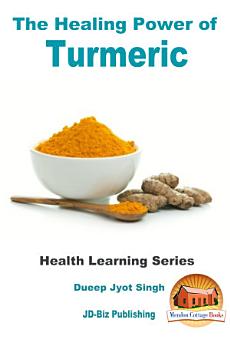The Healing Power of Turmeric
2016. g. jūn. · Mendon Cottage Books
4,4star
7 atsauksmesreport
E-grāmata
50
Lappuses
family_home
Piemērota
info
reportAtsauksmes un vērtējumi nav pārbaudīti. Uzzināt vairāk
Par šo e-grāmatu
Table of Contents
Introduction
Turmeric for Healing
Cultivation of Turmeric
Harvesting Time
Turmeric Diseases
Storing Fresh Turmeric
Turmeric for Beauty
Conclusion
The Danger of Online Incomplete Knowledge regarding the Usage of Natural Medicine, including Turmeric
Author Bio
Publisher
Introduction
In my previous books, where I have written extensively about herbs, especially when they are used for healing, in cuisine and for beauty, I have normally spoken about herbs which are found globally. However, thanks to the state-of-the-art transport system of the 21st century, I can talk about herbs, which were once unavailable to the common people in other lands and native to only just one particular part of the globe. And that is the reason why the healing qualities of many local and native herbs, like ginseng, lemongrass, and other such herbs, which were possibly not available to people in other corners of the earth were overlooked for centuries.
But that is definitely not the situation today. You can walk into any city market and request spices from all corners of the world and you just have to ask and you will be given. And that is why today, we are going to be talking about one of the most powerful healing herbs available in the world today, to mankind, turmeric.
Turmeric belongs to the ginger family, and it is a rhizome. It originated in the southwest part of the Indian subcontinent millenniums ago, and nobody really knows which particular civilization found out that this rhizome dug up from the ground, could be used fresh, to impart a golden color to anything, food, clothes, and skin!
Being a native of a tropical region, turmeric needs lots of rain. The average temperature outside has to be around 20°C – 30°C, for this particular plant to survive.
When I was a child, I often saw one of our gardeners who also was a native herbalist going out into the woods and coming back triumphantly with these dug up rhizomes in her hand. They looked like ordinary ginger to me. So that is when I found out that these rhizomes were boiled for about 45 minutes and then allowed to dry in the sun in the shade for about 3 – 4 days. And after that the dried rhizomes would be ground in a pestle and mortar, to give a deep natural, yellow – orange powder, which was precious turmeric.
Introduction
Turmeric for Healing
Cultivation of Turmeric
Harvesting Time
Turmeric Diseases
Storing Fresh Turmeric
Turmeric for Beauty
Conclusion
The Danger of Online Incomplete Knowledge regarding the Usage of Natural Medicine, including Turmeric
Author Bio
Publisher
Introduction
In my previous books, where I have written extensively about herbs, especially when they are used for healing, in cuisine and for beauty, I have normally spoken about herbs which are found globally. However, thanks to the state-of-the-art transport system of the 21st century, I can talk about herbs, which were once unavailable to the common people in other lands and native to only just one particular part of the globe. And that is the reason why the healing qualities of many local and native herbs, like ginseng, lemongrass, and other such herbs, which were possibly not available to people in other corners of the earth were overlooked for centuries.
But that is definitely not the situation today. You can walk into any city market and request spices from all corners of the world and you just have to ask and you will be given. And that is why today, we are going to be talking about one of the most powerful healing herbs available in the world today, to mankind, turmeric.
Turmeric belongs to the ginger family, and it is a rhizome. It originated in the southwest part of the Indian subcontinent millenniums ago, and nobody really knows which particular civilization found out that this rhizome dug up from the ground, could be used fresh, to impart a golden color to anything, food, clothes, and skin!
Being a native of a tropical region, turmeric needs lots of rain. The average temperature outside has to be around 20°C – 30°C, for this particular plant to survive.
When I was a child, I often saw one of our gardeners who also was a native herbalist going out into the woods and coming back triumphantly with these dug up rhizomes in her hand. They looked like ordinary ginger to me. So that is when I found out that these rhizomes were boiled for about 45 minutes and then allowed to dry in the sun in the shade for about 3 – 4 days. And after that the dried rhizomes would be ground in a pestle and mortar, to give a deep natural, yellow – orange powder, which was precious turmeric.
Vērtējumi un atsauksmes
4,4
7 atsauksmes
Par autoru
John Davidson
Born and raised in Wyoming and Canada on Ranches. Studied at Utah State University and taught drafting at Bridgerland Applied Technology College for 20 years. Own and run several businesses, an architectural design business, a web design business and a Sawmill business. Married to Karla for over 30 years and have 4 great kids, living in Mendon, Utah.Novērtējiet šo e-grāmatu
Izsakiet savu viedokli!
Informācija lasīšanai
Viedtālruņi un planšetdatori
Instalējiet lietotni Google Play grāmatas Android ierīcēm un iPad planšetdatoriem/iPhone tālruņiem. Lietotne tiks automātiski sinhronizēta ar jūsu kontu un ļaus lasīt saturu tiešsaistē vai bezsaistē neatkarīgi no jūsu atrašanās vietas.
Klēpjdatori un galddatori
Varat klausīties pakalpojumā Google Play iegādātās audiogrāmatas, izmantojot datora tīmekļa pārlūkprogrammu.
E-lasītāji un citas ierīces
Lai lasītu grāmatas tādās elektroniskās tintes ierīcēs kā Kobo e-lasītāji, nepieciešams lejupielādēt failu un pārsūtīt to uz savu ierīci. Izpildiet palīdzības centrā sniegtos detalizētos norādījumus, lai pārsūtītu failus uz atbalstītiem e-lasītājiem.








